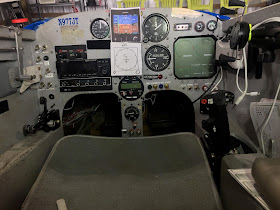Panel upgrade
Upgrading from what? You might ask, and you’d be correct in assuming I’m skipping a little foo far ahead... at least with this airframe.
I know, I know, this blog was supposed to be about my Long EZ build, but I have decided to do what I told everyone I wasn't going to do, a partial instrument panel upgrade on my already-flying airplane (the one Terry Lamp built), and pretty much everyone has told me they want to know what and how I am going to do it. So, it seemed fitting to share it here, with a crowd who’s already interested in such things. Besides, what I will have learned with this upgrade will be instrumental (no pun intended) when the time comes to wire up my other panel.
 |
| Instrument panel as is. I plan on keeping the engine instruments cluster (far right). |
Flying Terry’s plane has been just awesome, however I have reached the point where I just need more utility from it if I am to enjoy it on trips longer than a couple of hundred miles. You see, longer trips present a recurrent problem… one is bound to run into weather conditions that are not conducive to VFR flying (Visual Flight Rules). This greatly reduce the usability of the plane, and has the potential of becoming dangerous.
Mind you, I’m not looking to fly into “bad” weather, I get enough of that at work already, but it would be nice not to get stuck places just because a cloud deck rolled in while enjoying the proverbial $100 burger away from home, and so far I have avoided quite a few trips to visit friends (that I could have probably flown) out of an abundance of caution. I hate being at the mercy of the VFR gods every time I want to go somewhere.
Terry did a fantastic job putting together a very safe and redundant VFR plane, indeed it has most of what one would have wanted in the late 90's to make it IFR (Instrument Flight Rules) capable. The plane however is not certified for it, although the Operating Limitations certificate does not disallow it, stating that it is certified for day VFR unless the equipment stated in FAR 91.205 are also installed (I'm paraphrasing).
That equipment gap is what this panel upgrade will have to address.
Technically, I took my first step down the upgrade path a few months ago, when I replaced the VFR only GPS/COM Garmin GNC255XL with a Garmin refurbished, IFR capable GNC300XL. This radio was the obvious choice for a quick upgrade since it is physically identical to my previous unit, and the swap is just a matter of replacing it in the radio tray, no rewiring necessary.
 |
| Garmin GNC250XL (VFR GPS/COM) |
 |
| Garmin GNC300XL (IFR GPS/COM) |
The swap was easy, but a bit more is required for IFR flight.
The GNC300XL manual specifies that a CDI (Course Deviation Indicator), an altitude encoder source, and an annunciator panel are also required. You can see most of those in the next photo of an RV6 panel that belongs to friend of mine.
 |
| Some of the items needed to make a GNC300XL installation IFR |
Like my friend, I would have built my own annunciator panel, but unfortunately for me I have no additional space in my small instrument panel for a standalone CDI.
I wanted to do the least amount of modifications to the plane, but it started to look like anything new I tried to fit in the panel would require cutting bigger holes into the fiberglass. Pretty soon it became obvious that some of the panel could not be saved, so my next priority became cutting the smallest possible hole to install the necessary instruments.
The good news with having made the cutting decision is that the instrument choice became quite ample. So, let’s take a look at some of the available options (in no particular order)…
 |
| GRT HXr 10.4" plus GRT Mini-AP |
 |
| GRT HXr 8.4" plus GRT Mini-AP |
 |
| Dual Garmin G5 |
 |
| Dynon SkyView HDX1100 10" plus Garmin G5 |
 |
| Dual Dynon D10 |
 |
| Dynon D100 plus Garmin G5 |
 |
| Garmin G3X touch |
 |
| Dual GRT Mini-AP |
 |
| GRT Horizon Hx 6.5" plus GRT Mini-AP |
 |
| Dual Garmin G3 Touch |
My current plan is to replace a small portion of the instrument panel with an aluminum plate on which the new instruments will be mounted.
Stay tuned, because next time I will share what I chose to buy, and why.
No comments:
Post a Comment